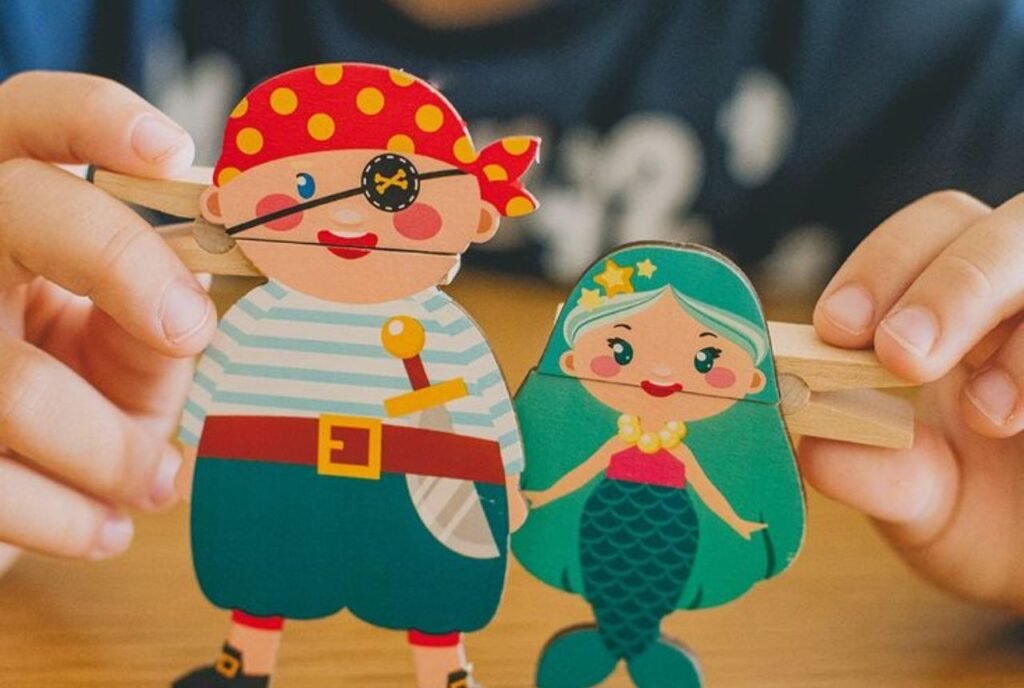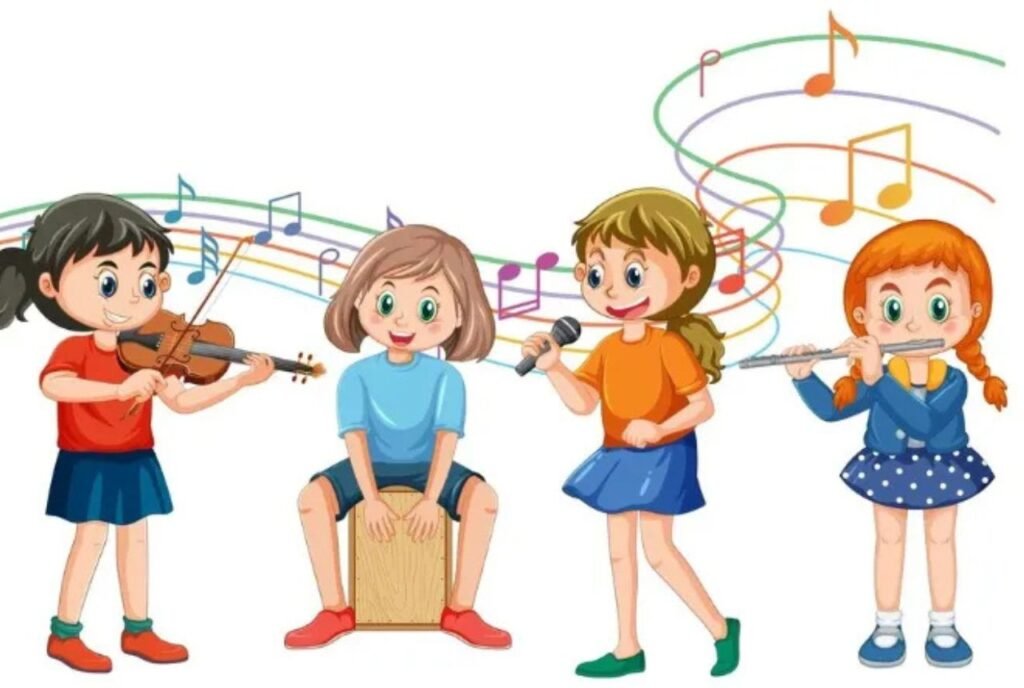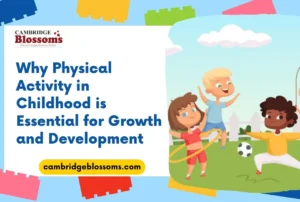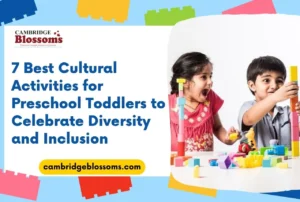Storytelling ideas for playschool kids are more than just fun activities—they’re powerful tools that nurture early childhood development. At the foundational age of 3 to 5 years, stories help young children understand the world around them, while improving language, memory, and emotional intelligence. From building vocabulary to cultivating empathy, storytelling plays a key role in shaping young minds.
At Cambridge Blossoms, a premier preschool in Guwahati, storytelling is thoughtfully integrated into daily learning using a variety of innovative methods. Their approach creates a strong foundation not only in literacy but also in social-emotional skills and cognitive development. These stories often mirror important life lessons, such as kindness, sharing, and even early concepts like nutritional guidelines for preschool kids.
In this blog, we explore five creative storytelling ideas for playschool kids that are both fun and educational. These methods promise to ignite imagination and encourage active learning.
Understanding the Power of Storytelling Ideas for Playschool Kids
Storytelling significantly influences the growth and development of children aged 3 to 5. At this stage, children absorb language rapidly, and storytelling helps expand their vocabulary while improving listening and speaking skills. Narratives also introduce children to problem-solving, character building, and empathy—all through relatable and engaging contexts.
When children hear and tell stories, they engage in cognitive tasks such as sequencing, prediction, and comprehension. It’s an excellent way to encourage imagination while also improving concentration and memory. To make storytelling more effective, a cozy environment with minimal distractions is ideal. Soft lighting, a reading corner, or even a circle on a classroom rug can become magical spaces for stories.
Parents and educators play a vital role in shaping storytelling experiences. Their enthusiasm, voice modulation, and expressions add life to stories and draw children into new worlds. At Cambridge Blossoms, storytelling is part of the core curriculum, where teachers use diverse techniques—from puppets to nature walks—to deliver meaningful narratives.
These stories not only entertain but subtly teach life skills, moral values, and even health habits, like the importance of following nutritional guidelines for preschool kids.
5 Engaging Storytelling Activities That Captivate Young Minds
1. Interactive Story Circles
Interactive Story Circles are a simple yet powerful way to encourage collaborative storytelling. Children sit in a circle and take turns adding a sentence to a story based on a prompt. For preschoolers, prompts like “A rabbit finds a magic hat…” spark imaginative ideas. Educators guide the process gently, helping children stay focused and engaged.

These circles teach essential skills like listening, turn-taking, and narrative development. As children gain confidence, the stories grow more complex. At Cambridge Blossoms, story circles often involve themes like healthy eating, subtly reinforcing nutritional guidelines for preschool kids while having fun.
2. Puppet Storytelling Adventures
Puppets are a magical tool for bringing stories to life. Playschool kids respond well to finger puppets, sock puppets, or simple paper puppets. Creating their own puppets becomes an exciting craft activity that supports fine motor development.

Puppet storytelling allows shy children to express themselves and makes character roles more tangible. Educators can model different voices and emotions, enhancing dramatic play. Storylines like “Mr. Apple teaches friends about healthy snacks” combine fun with nutritional education. Cambridge Blossoms regularly uses puppet shows to introduce emotional learning and healthy habits in a way that children love.
3. Nature-Inspired Story Mapping
Nature-inspired storytelling allows children to interact with their environment while creating imaginative plots. Using materials like leaves, sticks, or pebbles, children build visual story maps on the ground or a large sheet. These elements represent characters, settings, or actions.

This hands-on activity strengthens spatial awareness and sequential thinking. For instance, a stick may become a bridge a character must cross to find a basket of fruits—linking the story to nature and healthy eating. At Cambridge Blossoms, teachers use this method during nature walks, encouraging children to tell stories that also spark environmental and nutritional awareness.
4. Movement and Music Storytelling
Combining storytelling with music and movement turns narratives into full-body experiences. Children can mimic characters’ actions—like tiptoeing through a forest or jumping like a kangaroo—while simple instruments like tambourines or homemade shakers add sound effects.

This method strengthens memory, rhythm, and coordination. Educators can create “story songs” such as “The Vegetable Parade,” teaching both vocabulary and nutritional guidelines for preschool kids. At Cambridge Blossoms, music-based storytelling helps children express emotions through movement, boosting their confidence and engagement in learning.
5. Picture Storyboarding for Little Creators
Storyboarding empowers children to visually sequence their thoughts. Using drawings, stickers, or magazine cutouts, children arrange events in a story from beginning to end. This is a great pre-literacy activity that also helps children understand the concept of order and cause-effect.

Teachers can guide children to create stories like “Riya’s Visit to the Fruit Market,” incorporating elements of healthy eating. Displaying their storyboards boosts confidence and creates a sense of achievement. At Cambridge Blossoms, these storyboards are regularly showcased to celebrate each child’s narrative creativity and build foundational writing skills.
Creating a Storytelling-Rich Environment at Home
Parents can easily recreate storytelling magic at home by setting up a dedicated space. A cozy reading nook with a few pillows, a small bookshelf, and soft lighting invites children into the world of stories. Keep materials like picture books, drawing paper, puppets, and musical instruments handy to spark spontaneous storytelling sessions.
Storytelling doesn’t have to be limited to books. It can be part of everyday routines—telling a story during bath time or inventing a tale during a walk. Parents don’t need to be expert storytellers; sincerity and imagination go a long way. Simple stories about grocery shopping or eating fruits can even reinforce nutritional guidelines for preschool kids in a natural way.
At Cambridge Blossoms, educators regularly communicate with parents, sharing storytelling techniques and even providing story starters for home use. This ensures continuity in the child’s learning journey and strengthens the parent-child bond. Parents are also invited to storytelling events, creating a shared learning ecosystem between school and home. With a little creativity, every home can become a space where stories nurture imagination and lifelong love for learning.
Measuring the Impact of Storytelling on Child Development
Storytelling leaves a noticeable mark on a child’s development. Children who regularly engage in storytelling activities often show enhanced communication, improved memory, and better emotional regulation. These benefits contribute significantly to school readiness.
Parents and teachers can observe signs such as increased vocabulary, eagerness to narrate their own stories, and empathy toward others. Storytelling also supports comprehension of abstract concepts—like understanding the value of good nutrition through character-led adventures about food choices.
At Cambridge Blossoms, storytelling progress is documented through observations, recordings, and child portfolios. Teachers note improvements in attention span, creativity, and expressive language. Backed by 2025 research on early education, storytelling is now widely recognized as a key driver of cognitive and emotional development in preschool-aged children.
Nurturing Young Minds Through Storytelling
From story circles to puppet shows, nature maps to music-driven tales, and colorful storyboards—these five storytelling ideas for playschool kids are designed to unlock imagination while supporting early learning milestones. When implemented with intention, storytelling becomes a transformative experience for children.
Parents and educators alike are encouraged to explore these activities and observe the joy and growth they bring. At Cambridge Blossoms in Guwahati, storytelling isn’t just a classroom tool—it’s a way of life.
Visit us to experience how imagination, learning, and even lessons like nutritional guidelines for preschool kids come alive through story. Let’s build a brighter future—one story at a time.




